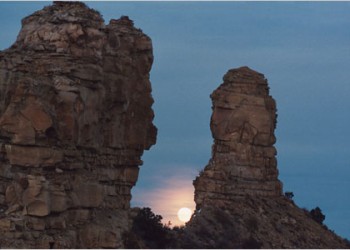Northern Major Lunar Standstill
What is the Northern Major Lunar Standstill at Chimney Rock?
Unlike the sun’s predictable path that repeats every year across the sky, the moon’s wandering path plays out on a longer, more subtle cycle. Over several decades, the ancestral Puebloans of Chimney Rock would have seen the moonrises shift gradually each year. In time they would have noticed that at the northernmost point in its multi-year journey, the full moon would rise between the rock pillars. Then, the moonrise crept southward again not to return to the embrace of the stone pillars until more than 18 years later.
Major Lunar Standstill Events in Fall, 2025
Chimney Rock National Monument has scheduled three final Major Lunar Standstill viewing events for Saturday, September 13, Sunday, September 14, and Sunday, October 12. Join us online or in person to view a livestream video of the Major Lunar Standstill. Visit Recreation.gov to purchase tickets to the in-person Major Lunar Standstill Celebration.
Griffith Observatory live stream:
- September 13: https://www.youtube.com/live/seT-dLgr008
- September 14: https://www.youtube.com/live/2WfnHf8QbzM
These late-night presentations will feature telescopes and stargazing under the Monument's majestic dark skies, presentations on astronomy, archaeology and culture from leading experts, Native American music, and a live-streamed viewing of the Moon rising between the natural pinnacles. After 2025, this dramatic moonrise won’t be seen again for 18 years.
Major Lunar Standstill Video

Moonrise at Chimney Rock is a short educational video exploring the rare Major Lunar Standstill—a celestial event that happens only once every 18.6 years and can be seen from Chimney Rock National Monument in southwest Colorado.
Tribal leaders from the Zuni Tribe and Pueblo of Tesuque share the cultural and spiritual significance of the moon and Chimney Rock to their communities. The video also uses clear visual simulations to explain the moon’s orbit and its unique alignment with the sun during this rare event.
This video was created through a partnership between the San Juan National Forest, tribal partners, and the University of Colorado Boulder’s Department of Astrophysical & Planetary Sciences.
Indigenous Artist Depiction
Ronnie Cachini was an indigenous artist from Zuni Pueblo, New Mexico. His artwork, seen on many interpretative panels throughout the monument, depicts the landscape, stories, history and heritage of the monument and its important to the Zuni people. The Zuni tribe is one of 25 tribes with a cultural or traditional affiliation to Chimney Rock. Click on image below to get the full display.What makes the Major Lunar Standstill (MLS) special?
The MLS is an astronomical event that occurs every 18.6 years. It is visible from Chimney Rock National Monument where the moon aligns between the two sandstone spires, Chimney Rock and Companion Rock. The rising is visible for a few days throughout the year over the course of three years.
Will there be public night viewing opportunities?
No, there will be no public night viewing opportunities from any location within the monument in 2025. For more information about the area closures, check out Forest Order, 02-13-06-23-03 and map.
In the past, visitors could view the MLS from a two-story fire tower.
What happened to the tower? The fire lookout tower was removed in 2010 because it was no longer needed due to advanced firefighting technologies, and the tower blocked astronomical alignments from the ancestral Puebloan structures. As a result, there is no longer a modern structure or location where the MLS can be viewed safely from the upper mesa.
Will the public be able to access the monument after the gates close each evening?
No public access will be allowed in the monument after hours of operation during periods and nights surrounding the rising events. Closure of the monument during these periods will be enforced.
Why is access restricted to Chimney Rock National Monument after hours?
The decision to restrict access to Chimney Rock National Monument during evening and night viewings is based on ensuring public safety. Specific considerations include:
- Hazards associated with hiking the strenuous upper mesa trail in the dark, especially as the trail is steep, rocky, and on a narrow ridgeline.
- Significant 1,000-foot cliffs on both sides of the trail.
- Lack of adequate safety lighting and cliff barriers.
- 7-mile round trip walk from the monument’s entrance gate.
- Potential wildlife encounters such as bears, mountain lions, rattlesnakes.
- No Forest Service personnel or emergency management services available.
- Limited cell phone service and long response time for emergencies.
- The only viewing location to observe the MLS is a small area on the upper mesa right along the cliff edge where the fire lookout tower once stood.



